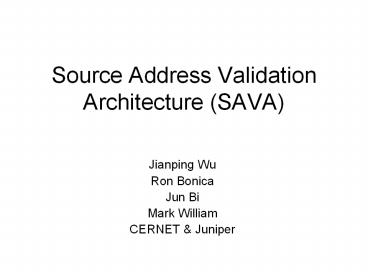Source Address Validation Architecture (SAVA) - PowerPoint PPT Presentation
Title:
Source Address Validation Architecture (SAVA)
Description:
Protects network resources from traffic with spoofed source addresses ... Both of these mechanisms are prone to the follow types of errors. False positives ... – PowerPoint PPT presentation
Number of Views:80
Avg rating:3.0/5.0
Title: Source Address Validation Architecture (SAVA)
1
Source Address Validation Architecture (SAVA)
- Jianping Wu
- Ron Bonica
- Jun Bi
- Mark William
- CERNET Juniper
2
What Does SAVA Protect
- Protects network resources from traffic with
spoofed source addresses - Does not seek to protect end-systems from traffic
with spoofed source addresses - The community already has a mechanism to protect
the end-systems (i.e., IPSec Authentication.)
3
What Is The Problem
- A network operator wants to deploy a forwarding
policy that includes, as one of its inputs, the
level of trust that the router places in the
validity of the packet's source address. - Currently, when a router receives a packet, the
level of trust that the router can place in the
validity of the packet's source address is low. - In order to increase that level of trust, the
router must validate the source address for
itself.
4
Best Common Practice
- Mechanisms are available for source address
validation - source address screening
- reverse path forwarding
- Both of these mechanisms are prone to the follow
types of errors - False positives
- False negatives
5
What Are The Constraints
- False positives are completely unacceptable
- It is better to deploy a filtering policy that
generates many false negatives than to deploy a
filtering policy that generates a single false
positive.
6
What Are The Gaps Between SAVA and BCP
- As the distance between the source of a packet
and the router doing the checking increases, so
does the likelihood of a false negative.
7
What Do Solutions Look Like
- SAVA seeks to implement a trust model, in which
a router that is close to the source of traffic
verifies the source address using one of the
existing mechanisms - That upstream router forwards the packet to a
downstream router, and somehow, indicates to the
downstream router the level of trust that it (the
upstream router) places in the packet's source
address.
8
Trust
- When the downstream router receives the packet,
the level of trust that the downstream places in
the packet's source address is a function of the
following - the level of trust that the upstream router
placed in the validity of the packets source
address - the level of trust that the downstream router
places in the upstream
9
Problems Remaining To Be Solved
- How does the upstream modify a packet to indicate
the level of trust that it places in the packets
source address - How does the downstream know when the upstream
has really done the checking that it claims to
have done
10
Whats Next
- Mailing List
- http//www.nrc.tsinghua.edu.cn/pipermail/sava
- Possible IRTF research group































